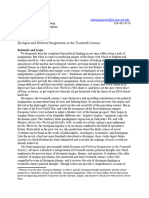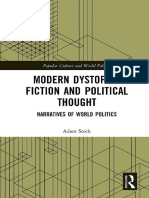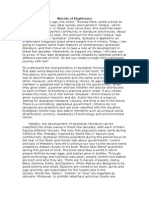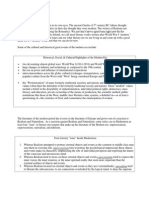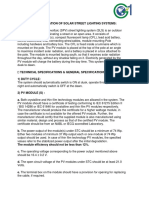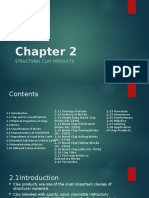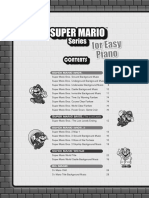Poster
Poster
Uploaded by
api-241692269Copyright:
Available Formats
Poster
Poster
Uploaded by
api-241692269Original Title
Copyright
Available Formats
Share this document
Did you find this document useful?
Is this content inappropriate?
Copyright:
Available Formats
Poster
Poster
Uploaded by
api-241692269Copyright:
Available Formats
Tales
of
Trauma:
The
Impact
of
World
Events
on
Dystopian
Literature
Haidyn
Pyfer
Abstract
Dystopian literature typically functions as an exaggerated
critique of current society, and so it has undergone many
evolutions that coincide with major world events.
Understanding this relationship helps us understand how
societies have processed trauma throughout history. Much
historical scholarship has been performed on dystopian
literature of the 20th century, but the most signicant
movement in modern dystopian literature has been the
growth of young adult dystopias. However, this subgenre
has not been studied in the same way as other dystopias,
and I would suggest that this movement be studied more
in order to understand the changing relationship between
young people and their society.
Figure 1
Background
Dystopian literature is a category of speculative ction
characterized by its depiction of bleak, unpleasant
civilizations. From the Ancient Greek words for bad and
place, dystopias represent unfavorable societies
(Adams). Dystopian literature is a natural response to
societys aOempts at its opposite: utopia. Utopias are
perfect paradise societies, so perfect that they cannot exist.
They are based on ideals of universal reason and
happiness, but these ideals are beyond the scope of
human nature (Sicher and Skradol 155). In order to achieve
the imagined utopia, human nature must be transformed,
and the modes of transformationsocial and genetic
engineering, eugenics, genocide, the banning of literature
or contrary thoughtbecome the hallmarks of dystopia.
State of the Scholarship
In order to understand the relationship between culture
and dystopian literature, scholars have examined the
literature from a historical perspective, and historical
scholarship on dystopias focuses heavily on the inuence
of major, traumatic world events. I have summarized this
historical scholarship in the table in Figure 1.
Figure 2
Future
Research
Though not included in the chart, the millennium also
brings a shift to dystopian literature for young adults.
These works deal specically with children and teenagers
responses to trauma and their political agency in a
post-9/11 world. Though the young adult movement in
dystopian literature is the larger development to come out
of the millennium (see Figure 2), liOle historical scholarship
exists on it. The majority of analysis on this literary
movement exists in the form of unpublished theses and
dissertations. This literatures status as young adult seems
to have resulted in a disregard for its academic value.
In order to beOer understand the state of our current
cultural environment we have to examine the literary
response to it: young adult dystopias. BeOer understanding
can be achieved by
Comparing characteristics of dystopias for adults to YA
dystopias
Examining the resources given to children for
processing trauma pre- and post-9/11
Analyzing the relationship young adults have to politics
before and after the millennium
These research options will help us to understand the
cultural shift that resulted in the rampant proliferation of
young adult dystopias.
I recommend we begin by conducting a microcosmic
analysis of the evolution only young adult literature in the
genre has undergone. It would be especially useful to
research the changes this subgenre has experienced since
the publication of Lois Lowrys The Giver. The Giver is one
of the rst popular dystopian young adult novels, and
changes in the genre since its publication in 1993 will
demonstrate the impact the age of terrorism has had on the
ways we communicate with children about our society.
References
Adams, John Joseph. "Dystopian Fiction: An Introduction." Tor.com. N.p., 11 Apr. 2011. Web. 14 Oct. 2015.
Chang, Hui-chuan. "Critical Dystopia Reconsidered: Octavia Butler's Parable Series and Margaret Atwood's Oryx and Crake as Post-Apocalyptic
Dystopias." Tamkang Review 41.2 (2011): 3-20. Web. 10 Oct. 2015.
Curwood, Jen ScoO. "The Hunger Games: Literature, Literacy, and Online Anity Spaces." Language Arts 90.6 (2013): 416-27. Web. 6 Oct. 2015.
Elliot, Amy. "Power in Our Words: Finding Community and Mitigating Trauma in James Dashner's The Maze Runner." Children's Literature Association
Quarterly 40.2 (2015): 179-99. Web. 6 Oct. 2015.
Hall, Alexander. ""A Way of Revealing": Technology and Utopianism in Contemporary Culture." The Journal of Technology Studies 35.1 (2009). Virginia Tech
Digital Library and Archives. Web. 6 Oct. 2015.
Hammond, Andrew. "The Twilight of Utopia: British Dystopian Fiction and the Cold War." The Modern Language Review 106.3 (2011): 662-81. Web. 10 Oct.
2015.
Hinl, Carrie. "Monica Hughes, Lois Lowry, and Young Adult Dystopias." The Lion and the Unicorn 26.2 (2002): 254-64. Web. 10 Oct. 2015.
Latham, Don. "Childhood Under Siege: Lois Lowry's Number the Stars and The Giver." The Lion and the Unicorn 26.1 (2002): 1-15. Web. 6 Oct. 2015.
Sicher, Efraim, and Natalia Skradol. "A World Neither Brave Nor New: Reading Dystopian Fiction after 9/11." Partial Answers: Journal of Literature and the
History of Ideas 4.1 (2006): 151-79. Web. 6 Oct. 2015.
You might also like
- El Ojo de Los DiosesDocument6 pagesEl Ojo de Los DiosesGinger Dane0% (2)
- Modern Dystopian Fiction and Political ThoughtDocument241 pagesModern Dystopian Fiction and Political ThoughtsaneblaiaNo ratings yet
- My Side of The Mountain PDFDocument61 pagesMy Side of The Mountain PDF12333% (3)
- Gems of Heaven Online PDFDocument284 pagesGems of Heaven Online PDFEdinNo ratings yet
- The Unexpected Popularity of Dystopian Literature - SkemmanDocument27 pagesThe Unexpected Popularity of Dystopian Literature - SkemmanOussama Ahmed Daoudi100% (1)
- 3D Modeling For BeginnersDocument202 pages3D Modeling For Beginnerssebanoriega6775% (12)
- 202 Products Name10-12-2009Document1,780 pages202 Products Name10-12-2009Ahmad FauzanNo ratings yet
- ASTM D5894-05 Standard Practice For Cyclic Salt FogV Exposure of Painted Metal (Alternating ExposuDocument4 pagesASTM D5894-05 Standard Practice For Cyclic Salt FogV Exposure of Painted Metal (Alternating ExposueliasNo ratings yet
- Introduction On The Spectacle in The Hunger Games SeriesDocument2 pagesIntroduction On The Spectacle in The Hunger Games SeriesMajda NizamicNo ratings yet
- Literature: Criticism of LifeDocument3 pagesLiterature: Criticism of LifeSagnik Bhattacharya100% (1)
- Kayla BlackburnDocument11 pagesKayla Blackburnapi-334500934No ratings yet
- Dystopian WorldDocument4 pagesDystopian WorldIanGiorgianaNo ratings yet
- Citizenship, Nationality and Ethnicity by T K Oommen PDFDocument84 pagesCitizenship, Nationality and Ethnicity by T K Oommen PDFadolbanadolbanNo ratings yet
- "Modernism or Postmodernism," An Essay Sanjit MandalDocument6 pages"Modernism or Postmodernism," An Essay Sanjit MandalSANJIT MANDALNo ratings yet
- Book Proposal - Cole - Fear The FutureDocument10 pagesBook Proposal - Cole - Fear The FuturePaul Luigi SalvoNo ratings yet
- Adam Stock - Modern Dystopian Fiction and Political Thought - Narratives of World Politics (Popular Culture and World Politics) - Routledge (2018)Document291 pagesAdam Stock - Modern Dystopian Fiction and Political Thought - Narratives of World Politics (Popular Culture and World Politics) - Routledge (2018)shreeya.malhotra19100% (1)
- The Major Issues in Teaching and Writing of Contemporary LiteratureDocument5 pagesThe Major Issues in Teaching and Writing of Contemporary LiteratureMónica GastónNo ratings yet
- Science Fiction: the Evolutionary Mythology of the Future: Volume Two: the Time Machine to MetropolisFrom EverandScience Fiction: the Evolutionary Mythology of the Future: Volume Two: the Time Machine to MetropolisNo ratings yet
- Total AbstractDocument263 pagesTotal AbstractKaram NayebpourNo ratings yet
- Dystopian Literature in The 21st CenturyDocument10 pagesDystopian Literature in The 21st CenturyShilow ElangaNo ratings yet
- Worlds of Nightmare, Speech On Dystopian LiteratureDocument3 pagesWorlds of Nightmare, Speech On Dystopian LiteratureSamin IeongNo ratings yet
- Fear and Loathing in Dystopia - The Ruckwartsroman and The NarratiDocument77 pagesFear and Loathing in Dystopia - The Ruckwartsroman and The NarratiyzuygulamaNo ratings yet
- BatmanDocument94 pagesBatmanAbhijnan SenguptaNo ratings yet
- Annotated Bib I RobotDocument9 pagesAnnotated Bib I Robotapi-352904439No ratings yet
- The Slave's Little Friends: American Antislavery Writings for ChildrenFrom EverandThe Slave's Little Friends: American Antislavery Writings for ChildrenNo ratings yet
- Modernity at Large, Book ReviewDocument2 pagesModernity at Large, Book ReviewaguazaladaNo ratings yet
- Alanoud Saeed FahadDocument6 pagesAlanoud Saeed FahadahmadelqenawyNo ratings yet
- (Perspectives On The Non-Human in Literature and Culture) Sonia Baelo-Allué and Mónica Calvo-Pascual - Transhumanism and Posthumanism in Twenty-First Century Narrative-Routledge (2021)Document251 pages(Perspectives On The Non-Human in Literature and Culture) Sonia Baelo-Allué and Mónica Calvo-Pascual - Transhumanism and Posthumanism in Twenty-First Century Narrative-Routledge (2021)MariusNo ratings yet
- Edging Into The FutureDocument287 pagesEdging Into The FutureSara PradoNo ratings yet
- Generation Gap in C. Lim's The Taximan's Story and J. Garcia - Villas' Footnote To YouthDocument18 pagesGeneration Gap in C. Lim's The Taximan's Story and J. Garcia - Villas' Footnote To YouthMICHELLE DIALOGONo ratings yet
- MML 2016 0016Document26 pagesMML 2016 0016João Victor CavalcanteNo ratings yet
- Handwriting EssayDocument3 pagesHandwriting Essayb6yf8tcdNo ratings yet
- Review Appadurai 2Document83 pagesReview Appadurai 2Dijia ChenNo ratings yet
- TESTER. Humanitarianism and Modern CultureDocument144 pagesTESTER. Humanitarianism and Modern CultureJoão Felipe Rufatto FerreiraNo ratings yet
- Shawn Mamuaja - 20091102028 - Scientific Writing AssignmentDocument2 pagesShawn Mamuaja - 20091102028 - Scientific Writing Assignmentshawnmamuaja406No ratings yet
- Embodied Utopias Gender, Social Change, and The Modern Metropolis. - Free Online LibraryDocument5 pagesEmbodied Utopias Gender, Social Change, and The Modern Metropolis. - Free Online Librarykarman.k.m.leungNo ratings yet
- Young Female Rebels Against Dystopian Regimes in Scott Westerfeld's Uglies (2005) and Lissa Price's Starters (2012)Document52 pagesYoung Female Rebels Against Dystopian Regimes in Scott Westerfeld's Uglies (2005) and Lissa Price's Starters (2012)Kirran Khumar GollaNo ratings yet
- Cultural Criticism and Wuthering HeightsDocument4 pagesCultural Criticism and Wuthering HeightsIoana FarcasNo ratings yet
- Modernism PostmodernismDocument9 pagesModernism PostmodernismAndreea Lita100% (1)
- 620.01 Annotated BibliographyDocument18 pages620.01 Annotated BibliographySophia DelgadilloNo ratings yet
- The Image of Dystopian Fiction and The Cultural Dialogues That They RepresentDocument3 pagesThe Image of Dystopian Fiction and The Cultural Dialogues That They RepresentIJELS Research JournalNo ratings yet
- A Time for the Humanities: Futurity and the Limits of AutonomyFrom EverandA Time for the Humanities: Futurity and the Limits of AutonomyRating: 2 out of 5 stars2/5 (1)
- Writing Culture and The Life of Anthropology Edited by Orin StarnDocument29 pagesWriting Culture and The Life of Anthropology Edited by Orin StarnDuke University Press100% (3)
- Past and Present: The Challenges of Modernity, from the Pre-Victorians to the PostmodernistsFrom EverandPast and Present: The Challenges of Modernity, from the Pre-Victorians to the PostmodernistsNo ratings yet
- The 31 Best Books To Read in High SchoolDocument13 pagesThe 31 Best Books To Read in High SchoolmeiNo ratings yet
- Humanism Essay2Free Will, Fortune, and The Soul: Humanist Perspectives On Social Equality and Human FreedomDocument13 pagesHumanism Essay2Free Will, Fortune, and The Soul: Humanist Perspectives On Social Equality and Human FreedomJonathan BandaNo ratings yet
- Agassi Sobre GellnerDocument23 pagesAgassi Sobre GellnerAlvaro FerreiraNo ratings yet
- Culture II Paper 1Document10 pagesCulture II Paper 1ingridNo ratings yet
- Society in DystopiaDocument9 pagesSociety in DystopiaMachete9812No ratings yet
- Unveiling Societal AnxietiesDocument2 pagesUnveiling Societal Anxietiesconnorabernathy99No ratings yet
- On The Relevance of Lit To LifeDocument12 pagesOn The Relevance of Lit To LifeliveavNo ratings yet
- This Content Downloaded From 60.254.0.139 On Tue, 03 Jan 2023 11:18:03 UTCDocument29 pagesThis Content Downloaded From 60.254.0.139 On Tue, 03 Jan 2023 11:18:03 UTCinkyheavenNo ratings yet
- Annotated BibliographyDocument6 pagesAnnotated BibliographyVutagwa JaysonNo ratings yet
- 1.1 The Role of Imagination in Narrative Construction-2Document21 pages1.1 The Role of Imagination in Narrative Construction-2RainforestLeadership MccaNo ratings yet
- LiteratureDocument3 pagesLiteraturezaryabalikhan08No ratings yet
- Article 2Document7 pagesArticle 2Lala LandNo ratings yet
- Study Guide for Decoding Brave New World: With Typical Questions and AnswersFrom EverandStudy Guide for Decoding Brave New World: With Typical Questions and AnswersNo ratings yet
- Haidynpyfer Resume2016Document1 pageHaidynpyfer Resume2016api-241692269No ratings yet
- Content StrategyDocument40 pagesContent Strategyapi-241692269No ratings yet
- Audit ReportDocument10 pagesAudit Reportapi-241692269No ratings yet
- Eds PostcardDocument2 pagesEds Postcardapi-241692269No ratings yet
- Rubik PDFDocument16 pagesRubik PDFSotirios HassapisNo ratings yet
- Helvetica: Helvetica, Is The First, Perhaps The Only Documentary About A Typeface, On A Subject, AnyoneDocument1 pageHelvetica: Helvetica, Is The First, Perhaps The Only Documentary About A Typeface, On A Subject, AnyoneSanjana BhandiwadNo ratings yet
- Asymmetric Grooves For Drumset (Part 1)Document4 pagesAsymmetric Grooves For Drumset (Part 1)Vladimir Lungu100% (2)
- Aurangzeb Emperor of Mughal India 195488Document4 pagesAurangzeb Emperor of Mughal India 195488kgsbhavaniprasadNo ratings yet
- The Plumb LineDocument10 pagesThe Plumb Linechouchou27100% (1)
- Technical Specification of Solar Street Lighting Systems PDFDocument3 pagesTechnical Specification of Solar Street Lighting Systems PDFnani yeshu100% (1)
- Chapter 2 Clays and BricksDocument50 pagesChapter 2 Clays and BricksPiolo Lim AvenidoNo ratings yet
- GR 5 - BUDDHISM - Student Note 5 - Sammodamana JatakaDocument2 pagesGR 5 - BUDDHISM - Student Note 5 - Sammodamana Jatakajagath2005ukNo ratings yet
- Propaganda FilmsDocument41 pagesPropaganda FilmsCherry100% (2)
- Fec 16 Project Mte PDFDocument7 pagesFec 16 Project Mte PDF2K19/CO/053 AMIT KUMAR JHANo ratings yet
- Rascal Does Not Dream of A Bunny Girl-Senpai (Google Docs)Document75 pagesRascal Does Not Dream of A Bunny Girl-Senpai (Google Docs)Tommy YothsackdaNo ratings yet
- Aladdin Dan Lampu Ajaib Bahasa Inggris StoryDocument2 pagesAladdin Dan Lampu Ajaib Bahasa Inggris StoryResty Novianti100% (2)
- CALLED FROM OBSCURITY: THE LIFE AND TIMES OF A TRUE SON OF TIBET GERGAN DORJE THARCHIN Vol.1Document618 pagesCALLED FROM OBSCURITY: THE LIFE AND TIMES OF A TRUE SON OF TIBET GERGAN DORJE THARCHIN Vol.1Ron Stalworth100% (1)
- A British Tradition at Christmas: Read The Text. Then Answer The QuestionsDocument2 pagesA British Tradition at Christmas: Read The Text. Then Answer The QuestionsMariam adiemNo ratings yet
- When This Was Where The Event Happened What Actually Took PlaceDocument8 pagesWhen This Was Where The Event Happened What Actually Took PlaceAle SieNo ratings yet
- NullDocument35 pagesNullnsadnan0% (1)
- Haunted House Screenplay AlexiDocument4 pagesHaunted House Screenplay Alexiapi-302861286No ratings yet
- Cable TrayDocument4 pagesCable TraySoltani AliNo ratings yet
- LF Ei Engineers India Limited: (For Cone Roof I Floating Roof Tanks)Document3 pagesLF Ei Engineers India Limited: (For Cone Roof I Floating Roof Tanks)sahilNo ratings yet
- "Pirates of The Caribbean: Dead Man's Chest" Film ReviewDocument2 pages"Pirates of The Caribbean: Dead Man's Chest" Film ReviewJoshNo ratings yet
- Premium: Akanksha Poj 1St Phase 2Nd Installment Under Premium and Classic CategoryDocument6 pagesPremium: Akanksha Poj 1St Phase 2Nd Installment Under Premium and Classic CategoryKalyan GaineNo ratings yet
- Wombat: A Men-Capable Banana-Shaped ShawlDocument2 pagesWombat: A Men-Capable Banana-Shaped Shawlavram2010100% (1)
- Super Mário PDFDocument6 pagesSuper Mário PDFJorgeGargaté100% (1)
- Home Reading ProjectDocument9 pagesHome Reading ProjectRica Avila100% (1)
- Peter R. Rodgers, The Text of Romans 8,28Document4 pagesPeter R. Rodgers, The Text of Romans 8,28NonadaPolites100% (1)















